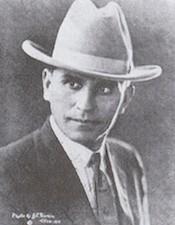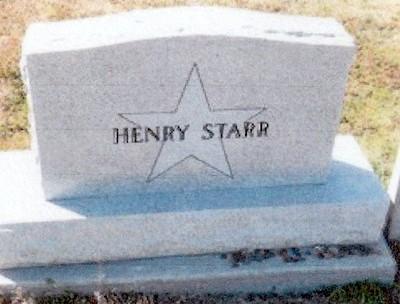 March 22, 2019 - Henry Starr claimed that he had robbed more banks than both the James-Younger Gang, and the Doolin-Dalton Gang put together. He began robbing banks on horseback in 1893, and ended up robbing his last bank in a Nash automobile in 1921. Thus, he was the first bank robber to use an automobile in a bank robbery. Henry is alleged to have robbed a total of 21 banks, making off with nearly $60,000 in money and gold.
March 22, 2019 - Henry Starr claimed that he had robbed more banks than both the James-Younger Gang, and the Doolin-Dalton Gang put together. He began robbing banks on horseback in 1893, and ended up robbing his last bank in a Nash automobile in 1921. Thus, he was the first bank robber to use an automobile in a bank robbery. Henry is alleged to have robbed a total of 21 banks, making off with nearly $60,000 in money and gold.
He was the most notorious bank robber of the old west. He glorified himself in his autobiography, and at least didn’t blame outside influences as some do, but called it his chosen path. Starr served a total of eighteen years in prison, and was generally a model prisoner.
Born in Indian Territory near what would later become Fort Gibson, Oklahoma, on December 2, 1873, Henry Starr was a horse thief, a train robber, a bank robber, and a convicted murderer. Interestingly, he wrote an autobiography and also starred in the silent film that was made from his memoirs. The movie was titled “A Debtor to the Law”.
Henry Starr was destined to become a criminal. His grandfather, Tom Starr, was known as “the Devil’s own”, and his father, George “Hop” Starr, was a bandit in his own right. His uncle, Sam Starr, was also an outlaw and was married to the infamous Belle Starr. Henry was part Cherokee, and grew up in Indian Territory near the Arkansas border. By age sixteen he had been arrested for bringing whiskey into Indian Territory, reportedly in a stolen wagon. He jumped bail and fled the territory.
Henry could not stay out of trouble with the law. He robbed his first bank in 1893, and in all that time he only killed one man, and even that is not for sure. Starr was sentenced to hang by “hanging Judge” Isaac Parker, but won a reprieve. Eventually, no less that President Theodore Roosevelt pardoned him for bravery in disarming a noted badman, Cherokee Bill, during a prison break. It is thought that his pardon was influenced because one of Starr’s relatives was a member of the Rough Riders in Cuba.
Starr then went straight, and got married, however the state of Arkansas wanted him extradited for an old bank robbery. Starr then teamed up with Kid Wilson and robbed more banks. He was eventually caught, and served four years in prison. After he was released he robbed fourteen more banks.
Starr just couldn’t stay straight. In 1915 he tried to rob a bank in Stroud, Oklahoma, but was wounded by a teenager, and captured. He went to prison again, and after his release, re-enacted his role in a movie in 1920. But, Starr went back to robbing banks. At Harrison, Arkansas, Starr attempted to rob two banks on the same day. Unknown to Starr, the president of the People’s National Bank, W. J. Myers had hidden a .38 caliber rifle in the bank vault, and while Starr was collecting the money, Myers shot him. Starr died four days later on February 2, 1921.
Henry Starr is buried in the Dewey Cemetery north of Dewey, Oklahoma on the east side of U. S. Highway 75.

For decades afterward, Starr supporters targeted the by-then blind W. J. Myers and his family. Myers’ grandson was even targeted for kidnapping and ransom. All attempt at revenge by the Starr family proved futile.








